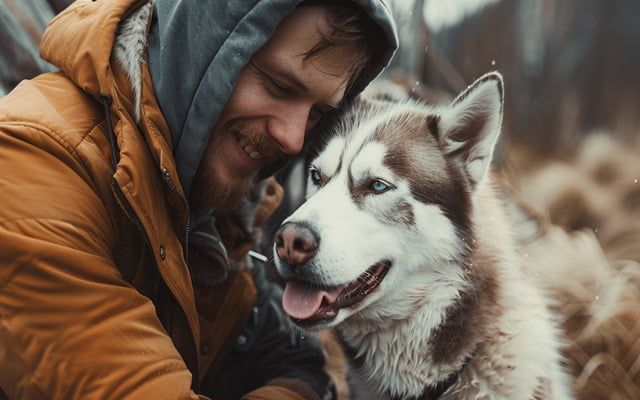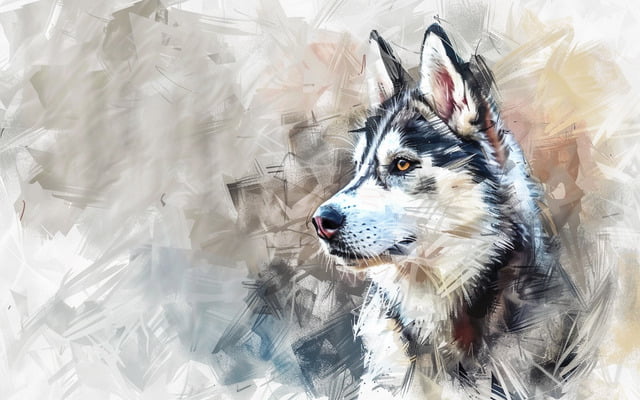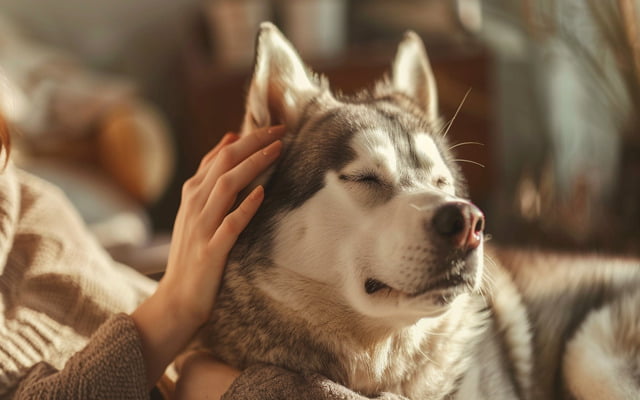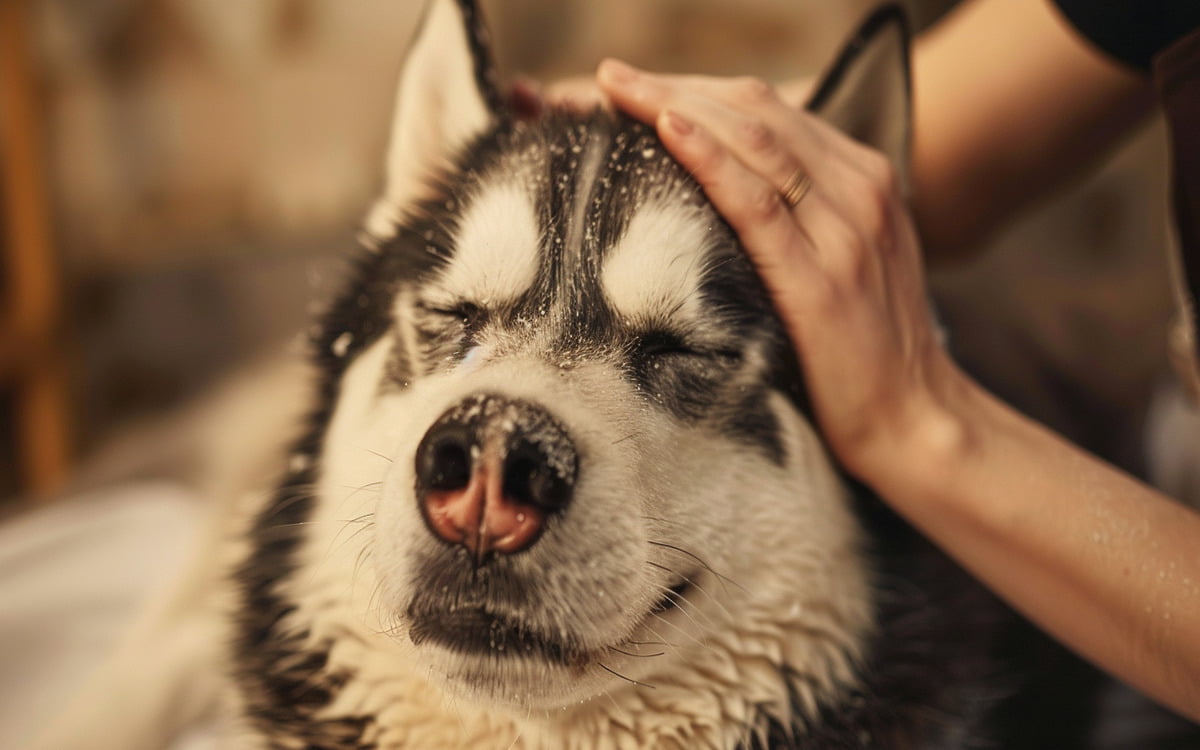Have you ever woken up to find tumbleweeds of fur roaming your living room? Or maybe your favorite black outfit is now permanently adorned with a husky-shaped, white fur silhouette? If you share your life with a Siberian Husky, you’re well-acquainted with the joys of their luxurious double coat. Husky Shedding Control, and while their majestic beauty is undeniable, the constant snowfall of fur can leave even the most patient dog owner feeling overwhelmed.
But fear not, fellow husky lovers! This comprehensive guide is here to equip you with the knowledge and tools to effectively manage your husky’s shedding. Unveil a treasure trove of shedding-control strategies that will transform your home from a winter wonderland of fur to a haven of manageable fluff.

Understanding Husky Shedding Control Like a Pro
Before we dive into the arsenal of shedding-control weapons, let’s gain a deeper appreciation for the “why” behind the fur flurry. Unlike your average pup, Siberian Huskies boast a double coat. A marvel of canine engineering designed for survival in harsh climates.
The magic lies in two distinct layers
- Topcoat: This outer layer is composed of long, coarse hairs that repel water and shield your husky from the elements, keeping them cool in summer and warm in winter.
- Undercoat: This dense, fluffy layer provides insulation, trapping warm air close to the body.
Here’s where the shedding story unfolds. Huskies naturally shed their undercoat twice a year, typically in spring and fall, to adapt their fur to the changing seasons. During these “blowout” periods, expect a dramatic increase in fur loss as the old undercoat makes way for a new, seasonally appropriate one.
But wait, there’s more to the shedding saga! Several factors can influence your husky’s fur loss beyond seasonal changes. These include:
- Age: Puppies tend to shed less than adult huskies, while senior huskies may experience increased shedding due to hormonal changes.
- Diet: A well-balanced diet rich in omega-3 and omega-6 fatty acids can promote a healthy coat and potentially reduce shedding.
- Stress: Environmental stressors like anxiety or illness can trigger excessive shedding.
- Sunlight exposure: Increased daylight hours in spring can stimulate shedding as your husky prepares for warmer weather.
| Factor | Explanation |
| Season |
Huskies experience heavy shedding twice a year (spring and fall) to adjust their coat for the changing seasons.
|
| Age |
Puppies shed less, while adult huskies shed more consistently. Senior huskies may shed more due to hormonal changes.
|
| Diet |
A nutritious diet rich in omega-3 and omega-6 fatty acids can promote a healthy coat and potentially reduce shedding.
|
| Stress |
Environmental stressors like anxiety or illness can trigger excessive shedding.
|
| Sunlight exposure |
Increased daylight hours in spring can stimulate shedding as your husky prepares for warmer weather.
|
Brushing Techniques for Peak Shedding Control
Brushing is the cornerstone of any successful shedding-control plan. Regular brushing removes loose fur before it has a chance to blanket your furniture and clothes. Aim to brush your husky at least once a week, and increase the frequency to daily during shedding seasons and “blowouts.”
Embrace the power of the brush trinity
- Undercoat rake: This miracle worker delves deep into the undercoat, extracting mountains of loose fur. Use it gently to avoid damaging the guard hairs.
- Slicker brush: This brush glides through the topcoat, removing loose hairs and distributing natural oils for a healthy shine.
- Deshedding tool: These innovative tools, like the FURminator, can be particularly effective during heavy shedding periods. Remember, use them according to the manufacturer’s instructions to avoid irritating your husky’s skin.
- Brushing with a Partner: Brushing time can be a fantastic bonding experience for you and your husky. Offer praise and treats throughout the process, transforming a chore into a pampering session for your furry friend.

Brushing Techniques for Peak Shedding Control
Brushing is the cornerstone of any successful Husky Shedding Control plan. Regular brushing removes loose fur before it has a chance to blanket your furniture and clothes. Aim to brush your husky at least once a week, and increase the frequency to daily during shedding seasons and “blowouts.”
Embrace the power of the brush trinity
- Undercoat rake: This miracle worker delves deep into the undercoat, extracting mountains of loose fur. Use it gently to avoid damaging the guard hairs.
- Slicker brush: This brush glides through the topcoat, removing loose hairs and distributing natural oils for a healthy shine.
- Deshedding tool: These innovative tools, like the FURminator, can be particularly effective during heavy shedding periods. Remember, use them according to the manufacturer’s instructions to avoid irritating your husky’s skin.
- Brushing with a Partner: Brushing time can be a fantastic bonding experience for you and your husky. Offer praise and treats throughout the process, transforming a chore into a pampering session for your furry friend.
Living with a Husky: Husky Shedding Control
Shedding control extends beyond just brushing and bathing. By creating a holistic environment that caters to your husky’s natural instincts, you can further minimize loose fur and promote a healthy coat.
Environmental Management for Reduced Shedding
- Temperature Control: Huskies are built for cold weather. Ideally, maintain your home environment at a cool temperature (around 60-68°F). Overheating can trigger excessive shedding as your husky attempts to cool down.
- Humidity Control: While huskies thrive in cooler temperatures, extremely dry air can exacerbate shedding. Consider using a humidifier to maintain a moderate humidity level (around 40-50%) in your home, which can benefit your husky’s skin and coat health.

Exercise for a Healthy Coat and Happy Dog
Regular exercise is essential for a husky’s physical and mental well-being. Physical activity promotes good circulation, which can contribute to a healthy coat and potentially reduce shedding.
During heavy shedding periods, consider shorter, more frequent exercise sessions to minimize the amount of loose fur released during exertion.
Conclusion
We’ve braved the blizzard of information and emerged equipped with the knowledge and tools to conquer the husky shedding avalanche. By implementing these strategies and tailoring them to your unique husky, you can create a more harmonious and fur- manageable home for everyone.
FAQs
Is there a difference between shedding and blowing out their coat?
Yes, shedding is a continuous process where huskies lose fur throughout the year. However, they experience “blowouts” twice a year, which are periods of intense shedding where they lose a large amount of undercoat in a short period.
How long do husky blowouts typically last?
Husky blowouts can last anywhere from 2-6 weeks, depending on the individual dog. Factors like age, overall health, and climate can influence the duration.
My husky seems to be shedding excessively outside of blowout seasons. What could be causing this?
Excessive shedding outside of blowouts could be caused by several factors, including stress, allergies, dietary deficiencies, or underlying health conditions. Consult your veterinarian to rule out any medical concerns.
Is it okay to use a human brush on my husky?
While a human brush might remove some fur, it’s not ideal for huskies. Their thick double coat requires specialized brushes like undercoat rakes and slicker brushes to effectively remove loose fur.
How hard should I brush my husky’s fur?
Use gentle but firm strokes when brushing your husky. Avoid brushing too harshly, which can irritate their skin or damage their coat.

Healthy dogs mean happy dogs, and that makes me happy! I’m here to share all the tips for keeping your best furry friend in top shape, from puppyhood to their golden years.

